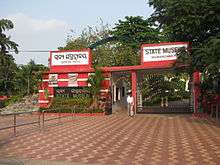Odisha State Museum
Odisha State Museum is a museum in Bhubaneswar, Odisha. In its original form it was established in 1932 and later moved to the current building in 1960.[1] The museum is divided into eleven sections, viz, Archaeology, Epigraphy, Numismatics, Armoury, Mining & Geology, Natural History, Art & Craft, Contemporary Art, Patta Painting, Anthropology and Palmleaf Manuscripts.[1] The museum is headed by a superintendent and the administrative control lies in the hands of Cultural Affairs Department, Government of Odisha.
ଓଡ଼ିଶା ରାଜ୍ୟ ସଂଗ୍ରହାଳୟ | |
 Entrance gate of the Museum | |

| |
| Established | 1932 |
|---|---|
| Location | BJB Nagar, Bhubaneswar, India |
| Coordinates | 20.2562°N 85.8415°E |
| Director | Manjushree Samantarai |
| Owner | Government of Odisha |
| Website | web |
History
The origin of this museum can be traced back to 1932, when some historians and professors, like William Jones, Ghanashyam Das, N. C. Banerjee, Harekrushna Mahatab established a museum in Ravenshaw College, Cuttack. In 1945-46, the Museum was shifted to Brahmananda building in old Bhubaneswar and given the status of a State Museum by the Government of Odisha.[1] Later, the Museum was shifted to Patel Hall in 1950 and again to another building in Unit - I, Bhubaneswar. In 1957, the foundation of the Museum was laid by then President of India, Rajendra Prasad, and finally the Museum in the current building started operating from 1960.[1]
Galleries
_-_Oct_2010.jpg)
- Archaeology
- Contemporary art
- Epigraphy
- Numismatic
- Arms and ammunitions
- Art and craft
- Mining & Geology
- Anthropology
- Sanskrit manuscript
- Patta painting
Timings
Opening timing is 10:00 AM to 5:00 PM all days of the week except Monday.
Photography
Photography is allowed inside the museum, prior permission needs to be taken while taking the tickets.
References
- Patel, C.B. "Origin and evolution of Orissa State Museum" (PDF). OHRJ. XLVII (3). Retrieved 11 March 2013.
External links
| Wikimedia Commons has media related to Odisha State Museum. |